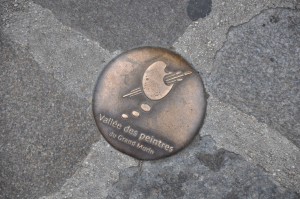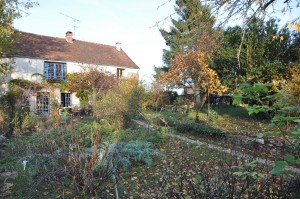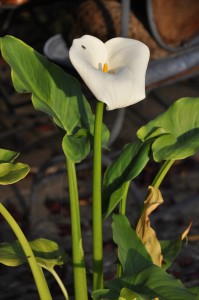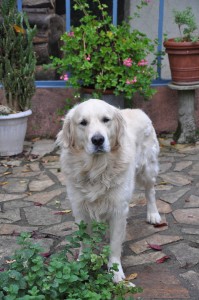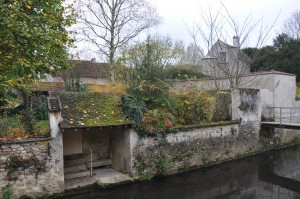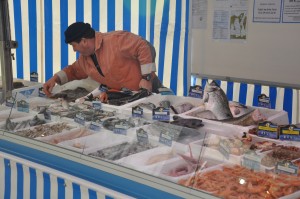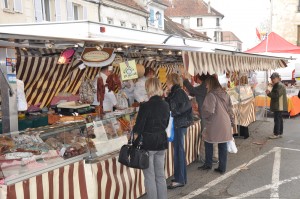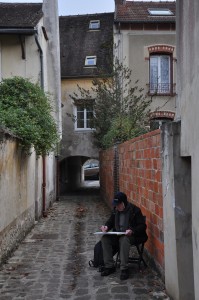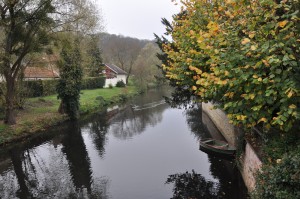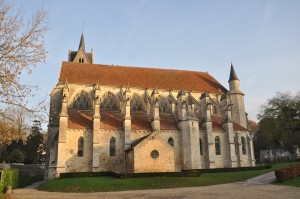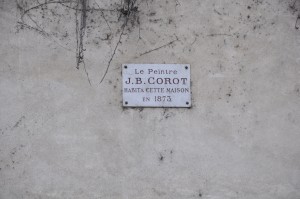Neither I nor my Dear One thought Crécy-la-Chapelle would have much to recommend it beyond access to the Champagne battlefields and a relatively short drive to Charles de Gaulle for our flight home. There were some charming pictures of the town center in spring and summer but nothing we could see through Google’s satellite-eye inspired us.
Milleroses is a comfortable gîte, of course, entirely suitable.
The garden is a romantic tangle of flowers and vegetable gardens overhung by the heavy green branches of firs. The owner Colette is a red-headed dynamo, the mother of artist-daughters (a ceramist and an animal sculptor or animalière) and a specialist in lymphatic drainage massage.
There is moreover our garde-chien, the big, beautiful Carat who walks us to our door but politely waits outside for us to come and play catch with his deflated soccer ball.
Yes, Crécy-la-Chapelle was the most practical choice for us. The battlefield of Champagne, in fact most of the Aisne-Marne is a hop-skip-and-a-jump down lovely country roads. So is the Forest of Chantilly with its Château Musée Condé. Paris is less than an hour away by train. It’s the town that caught my surprise, not for what it is convenient to but for what it is.
Modern Crécy-la-Chapelle, the “Venise Briarde,” came into being in 1972 with the merger of Crécy-en-Brie and La Chapelle-sur-Crécy. The villages arose on terrain occupied since the Neolithic era. For several hundred years the main industries appear to have been tanning and the milling of grain, and the sobriquet of the Venice of Brie comes from the series of canals dug to make use of the waters of the Grand Morin. In the 19th and 20th centuries, the area was a magnet for artists both modern and academic.
The most renowned of the landscapists was Camille Corot (1796-1875) who rented a house and built a studio in a ruined tower that was once part of the town’s fortifications. Vincent van Gogh (1853-90) swung through. The photographer Eduard Steichen (1879-1973) also had a house here and the Romanian sculptor Constantin Brancusi (1876-1957) joined Steichen there while creating the Endless Column. American, Canadian and Japanese painters admired the area’s churches, hillsides and responded to its changeable atmosphere and light.
Yeah, but just because the tourist brochures tout such connections, it doesn’t mean that a location is either interesting or fun.
Crécy-la-Chapelle is a blast.
The weather report promised partly cloudy skies and mild temperatures. Okay, it’s not the first time the meteorologists have been wrong. We drove down the hill into the town center discovered that Thursday is market day.
The Grand Place was filled with butchers and fishmongers, greengrocers and cheese vendors with massive wheels of gorgeously oozing brie, purveyors of clothes and household goods, and a fellow who will cane seats for your chairs.
We bought a roasted chicken from a cart in the market and vanilla éclairs from the Boulangerie du Marché for tonight’s supper and left them in the car then settled into a bar, La Cervoise on the rue du Marché, to get something to eat. It was possibly the best hamburger and heap of frites I have ever had in my life. We took note of Angelo’s Pizza, Le Commerce, a Chinese place, a kebab joint, and a creperie: so many reasons to stay and eat.
Fortified, we walked to the corner by the Office de Tourisme and studied the map of the walking tour we had picked up before lunch. That comparison to Venice is, in fact, apt. In particular I was put in mind of the quiet areas of the Dorsoduro. We walked down the Quai des Tanneries and wondered how long it had taken the waterways to be restored once effluent used to treat skins ceased pouring in. Three small towers, the third of which was belonged to Corot, are visible from the Quai.
We crossed the canal and angled our way through a narrow alley to encounter a modern paysagiste, an older gentleman scrunched on a stool, working on a watercolor of one of the towers.
We paused on a bridge over the Grand Morin and watched the steady flow of water. Over the doorway of St. George’s Church a sort of palimpsest and relic of the French Revolution identified the building as a Temple du Raison. I hope it is.
Back in the Grand Place, the sky darkened, the wind picked up, and there was no question that whatever sun was going to come had already gone. We returned to the car and imagined another visit, a month’s or year’s stay, in Crécy, walking to a boulangerie in the morning, stocking up on cheese and meat at the Thursday market, paddling down the waterways, walking in the hillsides. reading books and writing our chef-d’oeuvres. We turned left at the Beffroi, crossing yet another canal, to return to our car.
We decided the Collegial would have to wait for another time or another visit. We could never have anticipated that sunshine and spare time as we rolled down the hill toward the A-4 and the Aéroport Charles de Gaulle that the day would dawn bright and make sure we got a few pictures if nothing else.
Is Corot’s studio tower for rent?

